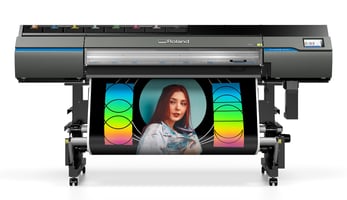Purchasing a printer for your business can be a major investment, similar to buying a vehicle. Both...
11 Reasons to Use LED Lighting in Your Signage

LED lighting has become a popular way to light homes, businesses, and more. But what are the benefits of switching to LED from traditional lighting?
The following are 11 reasons to use LED lighting in your signage.
Table of Contents
- Lifespan
- Energy Efficiency
- Safety and Durability
- Size
- Direct Emissions
- Dimmability
- Instant On
- No UV or IR Radiation
- Can Be Used Year Round
- Color Accuracy
- No Noise
1. Lifespan
LEDs last up to 40 times longer than incandescent bulbs and 2 to 4 times longer than fluorescent, sodium vapor, and metal halide lights.
On average, an LED bulb can last 50,000 to 100,000 hours.
To put that into perspective, if you left an LED bulb on for 8 hours a day, it would take 20 years before you needed to replace it.
2. Energy Efficiency
LEDs are not only long-lasting, but they are also very energy-efficient. Compared to other types of light bulbs, LEDs use up to 75% less energy. This is because LEDs convert more of their energy into light and less into heat.
Incandescent bulbs, on the other hand, convert about 90% of their energy into heat. This means that LEDs can save you money on your electric bill.
In fact, the initial price of an LED bulb is higher than other types of bulbs, but long-term savings can make up for the difference.
LED bulbs are also becoming more affordable, so the upfront cost is becoming less of a barrier to entry.
If you are looking for a long-lasting, energy-efficient light bulb, LEDs are the way to go.
3. Safety and Durability

LED bulbs are safer than traditional light bulbs because they do not produce heat. This means that there is less risk of fire or burns.
LED bulbs also operate on low voltage, which is another safety feature.
In addition, LED bulbs are made without filaments or glass enclosures, so they are more resistant to breakage and vibration. This makes them a safer choice for areas where there is a lot of activity or where the bulbs may be exposed to rough handling.
LED bulbs are also more environmentally friendly than traditional light bulbs. They do not contain mercury, which is a hazardous substance that is found in CFLs and some other types of light bulbs.
LED bulbs can simply be recycled at a qualified recycling center when they reach the end of their lifespan.
4. Size

LEDs are very small, measuring anywhere from a square millimeter to a tenth of a square millimeter. This small size makes them highly adaptable to any design and allows them to be used in a multitude of lighting applications.
For example, LEDs can be used to create small, decorative lights or to illuminate large areas. They can also be used to create specific lighting effects, such as flashing lights or colored lights.
In addition, LEDs are very versatile and can be controlled to emit different colors, brightness levels, and light distributions. This makes them a very versatile lighting solution that can be used in a wide variety of settings.
5. Direct Emissions

Traditional light bulbs emit light in a 360-degree radius. This means that most of the light is wasted, as it is not directed where it is needed.
In order to direct the light, reflectors or other devices are often used. This can add to the cost of the light bulb and reduce its efficiency.
LED lights, on the other hand, emit light in a 180-degree radius. This means that less light is wasted and that fewer reflectors or other devices are needed. As a result, LED lights are more efficient and can save you money on your energy bills.
They are also a good choice for applications where light needs to be directed in a specific way, such as in task lighting or accent lighting.
6. Dimmability
LEDs can be dimmed to any percentage between 0 and 100%, which gives you more control over the light output and can extend the lifespan of the bulb.
In fact, as an LED is dimmed, it becomes more efficient, meaning you can save even more energy.
Traditional light bulbs, on the other hand, tend to lose their brightness over time. LEDs, on the other hand, maintain their original brightness for their entire lifespan. This means you can use them for longer periods of time without having to replace them.
7. Instant On
Unlike traditional light bulbs, which take time to heat up and reach full brightness, LEDs reach full brightness instantaneously.
This is because LEDs do not use a filament to produce light, like traditional light bulbs. Instead, they use semiconductors that emit light when electricity is passed through them.
This instant on/off feature makes LEDs ideal for applications where lights are frequently switched on and off, such as in sensor lights and flashing light displays.
Traditional light bulbs, on the other hand, can degrade over time when they are switched on and off frequently. This is because the filament inside the bulb can break down each time it is heated up and cooled down.
LEDs, on the other hand, are not affected by this rapid cycling and can last for many years even when they are switched on and off frequently.
8. No UV or IR Radiation
UV radiation is a type of electromagnetic radiation that has a wavelength shorter than visible light. UV radiation can cause damage to DNA, which can lead to skin cancer and other health problems. LEDs do not emit UV radiation because they use semiconductors to produce light. Semiconductors emit light when electricity is passed through them, and they do not emit UV radiation unless they are specifically designed to do so.
IR radiation is a type of electromagnetic radiation that has a wavelength longer than visible light. IR radiation can cause heat, and it can also be used to detect objects in the dark. LEDs do not emit IR radiation because they use semiconductors to produce light. Semiconductors emit light when electricity is passed through them, and they do not emit IR radiation unless they are specifically designed to do so.
The fact that LEDs do not emit UV or IR radiation is beneficial for a number of reasons:
-
It is safer for human health. UV radiation can cause skin cancer and other health problems, while IR radiation can cause heat stress and other health problems. LEDs do not emit either type of radiation, so they are a safer choice for lighting applications.
-
It is better for the environment. UV radiation can damage plants and animals, while IR radiation can contribute to climate change. LEDs do not emit either type of radiation, so they are a better choice for the environment.
-
It can protect signage from fading and damage. UV radiation can cause signage to fade and become damaged. IR radiation can also cause signage to fade and become damaged. LEDs do not emit either type of radiation, so they can help to protect signage from fading and damage.
9. Can Be Used Year-Round

LEDs can operate in a wide range of temperatures, from -40°F to 140°F. This makes them a good choice for outdoor lighting, as they can withstand even the coldest winters.
In fact, LEDs actually perform better in colder temperatures than other types of light bulbs. This is because LEDs do not rely on heat to produce light, unlike incandescent and fluorescent bulbs.
In cold temperatures, other types of light bulbs can require a higher voltage to operate, which can shorten their lifespan. LEDs, on the other hand, do not need higher voltage in cold weather.
In fact, some studies have shown that LEDs can actually increase their efficiency by up to 5% in colder temperatures. This makes LEDs a good choice for refrigerated areas, as well as outdoor lighting.
10. Color Accuracy

The color rendering index (CRI) is a measure of how accurately a light source reflects the true colors of objects.
A CRI of 100 is considered ideal, and LEDs typically have a CRI of between 65 and 95. This means that LEDs can accurately render the colors of objects, making them a good choice for applications where color accuracy is important.
For example, LEDs are often used in photography and videography, as well as in retail settings where it is important for products to look their best.
In addition to their high CRI, LEDs can also be purchased in a wide range of colors. This means that you can find LEDs to match the specific color requirements of your application.
For example, you can find LEDs that produce warm white light, cool white light, or even colored light.
LEDs are also more energy-efficient than traditional light bulbs, so they can save you money on your energy bills.
They are also more durable than traditional light bulbs, so they are less likely to break or shatter.
Overall, LEDs are a versatile and efficient lighting option that can be used in a wide variety of applications.
11. No Noise
The filament in traditional light bulbs and fluorescent lights heats up and cools down when turned on and off, which can cause clicking or flickering noises.
LED lights, on the other hand, do not have a filament. They use semiconductors to produce light, which does not cause clicking or flickering noises.
In addition, LED lights are designed to operate silently. This means that they do not produce any audible noise, even when they are turned on or off.
As a result, LED lights are a good choice for applications where noise is a concern, such as in bedrooms, offices, and libraries.
In Conclusion
LED lighting is a continuously growing and improving technology that offers a number of advantages over traditional lighting. If you are looking for a long-lasting, energy-efficient, and safe lighting solution, LED lighting is the perfect choice.
Check out the LED lighting solutions we offer from brands like Allanson, France, G2G, P Industries, and more.



.jpg?height=200&name=1080-Gloss%20Flip%20Psychedelic-1%20(1).jpg)
